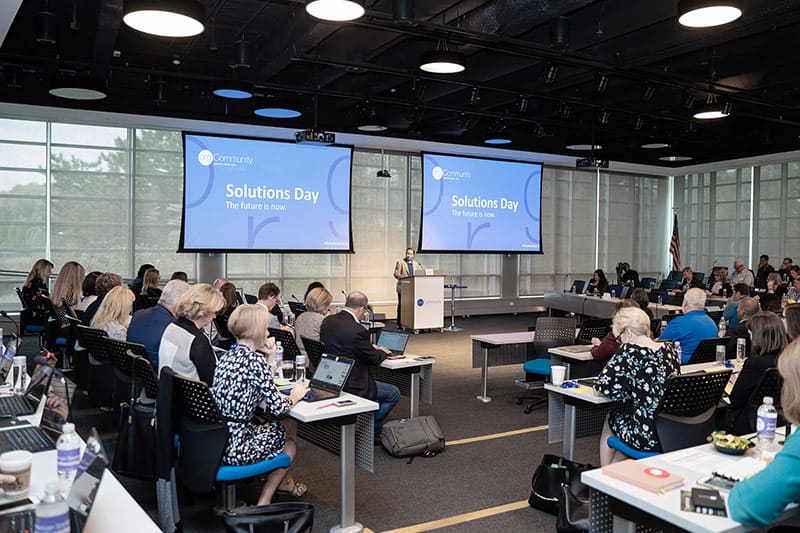
Until recently I knew zip about dog grooming, restoring vintage clothing, or Chinese cooking. While I might take a stab at making Shaking Beef, I’m still not going to style a Labradoodle or remove the stains from 50-year-old lace. But I have learned a few things about each of those topics.
Why dive into subjects that are off my beaten path of discovery? For one compelling reason. The YouTubers who manage those channels know how to tell a story and they are experts in their field. Passion plus knowledge is a powerful hook, making people who were about to swipe stay for a while. It gives brands authenticity, authority, and a dose of highly contagious excitement.
That’s the beauty of thought leadership. Thought leadership is an old idea that has been made new again. The term was coined in 1994 by Joel Kurtzman, who was the founding editor-in-chief of Strategy+Business magazine and editor of the Harvard Business Review. He defined it as “those people who possess a distinctively original idea, a unique point of view, or an unprecedented insight into their industry.”
Kurtzman believed that thought leaders should help shape the way people think about the world by sharing their ideas and insights and by challenging the status quo.
My YouTube examples don’t quite fit this lofty definition. But, here is a more contemporary take on the concept from Leah Hardy, Head of Gaming Marketing, Americas, Facebook. Hardy captures what most marketers are striving to accomplish today. She also makes an important point about the shift in persuasive strategies away from the aggressive sales pitch and toward a more genuine and personalized approach. This advice is especially relevant for anyone looking to attract a younger audience.
“Thought leadership is a powerful way to engage an audience that prefers to be educated versus sold to. Companies often make the mistake of trying to sell through the lens of what’s best for them, versus what’s best for their audience. Thought leadership helps bring your audience on a journey of shared understanding and insights, in order to drive toward impactful solutions.
“Born from necessity, the pandemic catalyzed the shift to a more digitally-driven selling process, and consequently thought leadership has become an increasingly important top of the funnel marketing tool.”
Thought leadership is a strategy that seems tailor-made for associations. After all, we are the home of professional experts. And our most ardent volunteers are typically people who love sharing knowledge.
So how do you begin to tap this new resource?
Be Deliberate

Here’s one significant challenge. According to a 2020 Edelman study, 89% of decision-makers surveyed believe that thought leadership improves their perceptions of an organization — yet only 17% of them rate the quality of the information they read as very good or excellent.
Rounding up a group of members who are eager to share their wisdom might seem like a fairly simple proposition. My first bit of advice is, don’t treat recruiting these experts casually. They will be representing your organization. Someone with the wrong attitude or who doesn’t understand the goals can do more harm than good.
Design a program that reflects the customized service you want to deliver and the quality of outreach you want to produce. Consider how you will integrate thought leaders into your current marketing plan and how your plan might expand with this additional support.
Identify Your Public
Associations have several broad categories of constituents including members, industry professionals, prospective members, and the public. There are multiple smaller interest groups in each area. Take Hardy’s advice. Look outward. Make decisions based on what will be most appealing to these segments of your population, rather than what is expedient or what insiders believe is important to the organization.
Jane Pearson, .orgSource Vice President of Marketing and Communications, offers this guidance, “In the post-pandemic world, people crave connection. Associations are ideally positioned to fill that need in a way that social media and other online activities cannot. Watch what is trending online. Meet people where they are going, not where you imagine they want to be.”
Do the Research

I hope I’m preaching to the choir. Even if you think you know your constituents, don’t dictate or guess about what they want to learn. Use data to make objective decisions based on site traffic, evaluations, sales, professional development activity, focus groups and/or other types of outreach. And, don’t rely on information that’s several years old. These days favorite playlists change quickly!
To sort your options, try creating a matrix like this.
| Audience | Platform | Topics |
| Members | Website, newsletter, webinars, conferences, social, podcasts, professional development, forums, YouTube | Industry trends, emerging technologies, best practices, case studies, member success stories, business marketing, entrepreneurship |
| Industry partners | Forums, LinkedIn groups, podcasts, collaborative blogs, whitepapers, co-branded content | Innovations, challenges and solutions, future predictions, market insights |
| Prospective members | Social, YouTube, Website, podcasts, webinars, professional development, other industry publications | Member success stories, Why I joined, What XYZ Association means to me |
| The public | YouTube, Social, local news outlets, website | How this industry helps the public, why you need professional advice, little-known facts about our industry |
A chart isn’t a blueprint, it’s a sketch, a point of reference that should grow and change based on input from members and thought leaders. These ideas may be obvious to association staff, but they may not be clear to the pundits you hope to attract. So, this exercise is also a marketing tool.
Evaluate Expertise
Who exactly are the members of your new brain trust and where will you find them?
First, let’s make this distinction. Influencers are not necessarily thought leaders. You are looking for experts. A social media following doesn’t guarantee that exclusive pedigree. Although an expert who comes with a big social network would be at the top of my list.
You might even begin your search by following related hashtags on social platforms or industry forums. These are other areas to explore:
- Professional networks—Put out the word among board, committee, and other volunteer groups.
- Industry events—Monitor the headline speakers and their audiences. Consider first-time speakers who draw a crowd. They may be eager for greater exposure.
- Industry publications and research—Identify which authors are most visible and command the greatest credibility.
- YouTube—Research who is featured on TED Talks or other video productions. Do any of your members have their own channel?
Filter your list by:
- Area of expertise—Does this person have the knowledge and experience you are seeking?
- Reach—Are they popular with the audience you are trying to attract?
- Impact—Do their ideas and insights make a difference?
Make it Easy
Once you’ve identified a prospect, make playing on your team an opportunity that’s easy, fun, and offers some kind of ROI. (For example, discounts on meetings or membership in exchange for an article or an appearance.)
This is probably the most challenging piece in the puzzle. As renowned members of their profession, your dream team may also require or expect significant hand-holding. The more clarity you can bring to their responsibilities, the better.
Treat this relationship like a formal engagement. Have a point person on staff ready to help with logistics. Document both employee and volunteer responsibilities. This is critical. Lines that aren’t clearly drawn are easily erased by a persuasive argument.
Review expense policies, conflict of interest, or any other relevant policies or ethical issues. Respect your thought leaders’ creativity and allow enough flexibility to stimulate innovation.
Adding volunteers to your organization, especially VIPs who are accustomed to white glove treatment, can seem like a deliberate complication. Approach the project slowly and learn as you go.
In a YouTube world thought leaders command attention. They will guide your audiences down new paths of discovery and build bridges to member engagement. Grow their authenticity, authority, and enthusiasm, and you will grow your organization.


